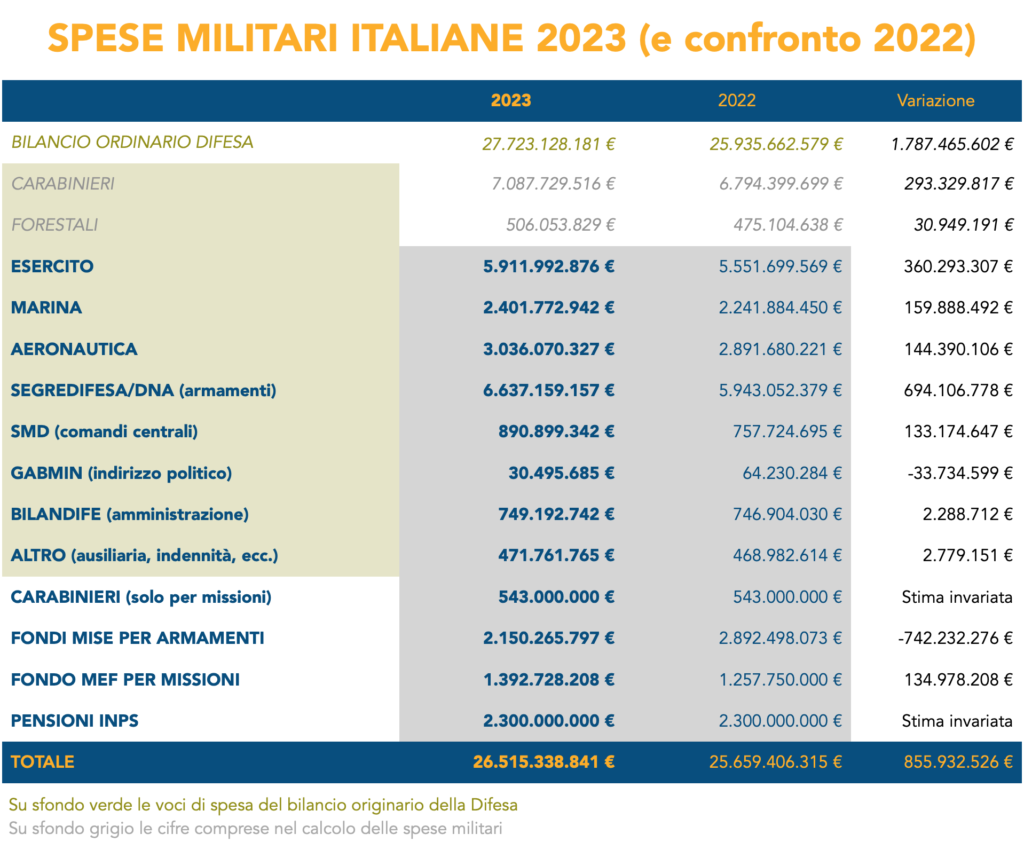The preliminary estimate – carried out by the Mil€x Observatory based on the tables presented by the government with the new Budget Law – shows an increase of over 800 million
The strong growth trend for Italian military spending will continue next year. This is shown by the preliminary estimates of the Mil€x Observatory deriving from the processing of the data contained in the Tables of the provisional budgets of the Ministry of Defence and the other ministries that contribute to Italian military spending (formerly Mise, and Mef) attached to the Budget Law 2023 sent by the Government to Parliament: the new overall increase is over 800 million euros.
Taking into account also the net military pension expenditure borne by Inps (national pension fund), in addition to the ministries’ allocations of funds according to the methodology adopted by Mil€x, the increase goes from the 25.7 billion forecast for 2022 to the 26.5 billion euro estimated for next year.
Driving the increase is the ordinary Defence budget (which also includes non-military expenditure for the Carabinieri in a public order function), which rises from 25.9 to 27.7 billion euro due to the higher personnel costs of the Army, Navy and Air Force (more than 600 million more) and the greater direct resources allocated to the purchase of new armaments (almost 700 million more). Approximately one hundred million euro more is planned for the administration and central commands, as well as for various allowances such as auxiliary staff. It should be emphasised that the overall increase recorded in the Defence budget derives for about one billion from funds provided for ‘at current legislation’ (i.e. deriving from the choices of previous years, in particular those of the Draghi government) and for the remaining approximately 700 million euro from decisions directly attributable to the Meloni government’s budget decisions.
Another by now fundamental item of military expenditure (and for years very significant both in terms of figures and operational and structural value) is the cost of military missions abroad, which are financed by a fund allocated to the budget of the Ministery of Economy and Finance and then transferred to Defence after parliamentary passage. In 2023, the endowment will be over 1.5 billion euro (up by 150 million from the previous year), 90% of which (i.e. almost 1.4 billion) can be attributed to direct military functions. Investments for new armaments remain at the high levels already recorded in 2022: the increase already highlighted in the Ministry of Defence budget is in fact offset by an almost equivalent decrease in indirect resources coming from the former Mise (now the Ministry of Enterprise and Made in Italy), with a consequent confirmation of the overall annual budget earmarked for national rearmament at over 8 billion euro.
Once the Budget Law is approved, the Mil€x Observatory will publish a more in-depth report on Italian military spending 2023, including an estimate of the so-called “NATO integrated budget” and thus its percentage on national GDP.

NOTE ON METHODOLOGY
Let us recall that, starting from a definition of military expenditure that is now shared (and aligned with that of the major international research institutes), our Mil€x Observatory considers the total amount of the Defence Budget as a mere starting point for assessing overall Italian military expenditure. This figure must in fact include additional funds entered in other ministries (mainly the fund for military missions abroad, which is set up at the Ministry of the Economy and Finance, and the funds that the former Ministry for Economic Development makes available for the acquisition and development of weapons systems) and must instead see the vast majority of the Carabinieri Corps’ budget subtracted for consistency of destination and type of use (due to the specific role played by this structure, in particular the forestry part), which is considered only for the component linked to missions abroad.
The new methodology of the Mil€x Observatory on military spending, updated and improved in 2021, also includes in the count figures deriving from other considerations (share of the cost of US bases, amortisation of mortgages on MISE armament spending, impact of military pensions) as will be explained in the in-depth report at the beginning of 2023.

